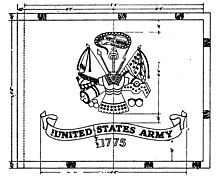
The coat of arms of the state of New Jersey includes:

The flag of the United States Marine Corps is the flag used to represent the U.S. Marine Corps, as well as its subsidiary units and formations.

In military organizations, the practice of carrying colours, standards, flags, or guidons, both to act as a rallying point for troops and to mark the location of the commander, is thought to have originated in Ancient Egypt some 5,000 years ago. The Roman Empire also made battle standards reading SPQR a part of their vast armies. It was formalized in the armies of Europe in the High Middle Ages, with standards being emblazoned with the commander's coat of arms.

Campaign streamers are decorations attached to military flags to recognize particular achievements or events of a military unit or service. Attached to the headpiece of the assigned flag, the streamer often is an inscribed ribbon with the name and date denoting participation in a particular battle, military campaign, or theater of war; the ribbon's colors are chosen accordingly and frequently match an associated campaign medal or ribbon bar. They often are physical manifestations of battle honours, though this does not mean all streamers are battle honours. They should not be confused with a tassel, which is usually purely decorative in nature.
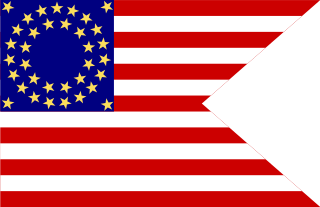
In the United States Armed Forces, a guidon is a military standard or flag that company/battery/troop or platoon-sized detachments carry to signify their unit designation and branch/corps affiliation or the title of the individual who carries it. A basic guidon can be rectangular, but sometimes has a triangular portion removed from the fly.
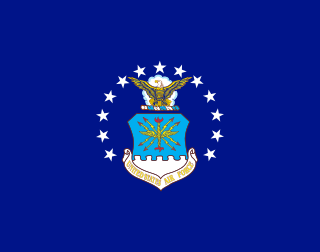
The flag of the United States Air Force was introduced in 1951 and consists of the U.S. Air Force's crest and shield, which itself comprises 13 white stars and the Department of the Air Force's coat of arms on a field of blue. The 13 stars represent the 13 original British American colonies, the three star grouping at the top portray the three Departments of the Department of Defense. The crest includes the North American bald eagle, the cloud formation depicts the creation of a new firmament, and the wreath, composed of six alternate folds of silver and blue, incorporates the colors of the basic shield design.

The flag of the United States Navy consists of the seal of the U.S. Department of the Navy in the center, above a yellow scroll inscribed "United States Navy" in dark blue letters, against a dark blue background.

The 26th Infantry Regiment is an infantry regiment of the United States Army. Its nickname is "Blue Spaders", taken from German soldiers in World War I, seeing the spade-like device on the regiment's distinctive unit insignia, and calling those soldiers “Blauerspadern”. The 26th Infantry Regiment is part of the U.S. Army Regimental System; currently only the 1st Battalion is active and assigned to the 2nd Brigade Combat Team, 101st Airborne Division.

II Field Force, Vietnam was a United States Army Corps-level command during the Vietnam War.

The Department of the Army Seal and the Department of the Army Emblem are, respectively, the official seal and emblem of the United States Department of the Army. The "War Office Seal" was created in 1778 and the Emblem was developed out of the seal and approved in 1947.

The 50th Infantry Regiment is a United States Army infantry regiment.
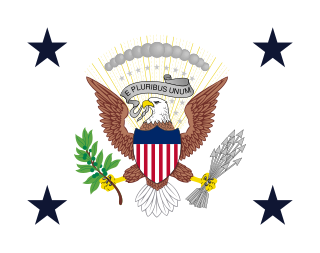
The flag of the vice president of the United States consists of the U.S. vice presidential coat of arms on a white background, with four dark blue stars in the corners. A version of the flag is kept in the vice president's office, is sometimes displayed by the vice president in official photos, and is flown on the vice president's motorcade.

The 33rd Armor Regiment was an armored regiment in the United States Army first formed in 1941. In 2005, the 33rd Armor was redesignated 33rd Cavalry Regiment. The 1st Squadron, 33rd Cavalry Regiment, a part of the 3rd Brigade Combat Team, 101st Airborne Division, carries on the lineage of 33rd Armor Regiment.

The 319th Field Artillery Regiment, more commonly referred to as the 319th Airborne Field Artillery Regiment, is a parent regiment in the U.S. Army Regimental System. Four battalions of the regiment are currently active. The first three battalions 1st Battalion, 319th Field Artillery Regiment, 2nd Battalion, 319th Field Artillery Regiment, 3rd Battalion, 319th Field Artillery Regiment are in the 82nd Airborne Division and the 4th Battalion, 319th Field Artillery Regiment is in the 173rd Airborne Brigade.

The 1st Field Artillery Regiment is a Field Artillery regiment of the United States Army first formed in 1907. The regiment served with the 4th Division and 6th Division before World War II, and with the 6th Infantry Division during and after World War II through 1956. Currently organized as a parent regiment under the U.S. Army Regimental System, elements of the regiment have served with the 1st Armored and 5th Infantry Divisions and with various artillery groups. The lineages of some of the units that make up the 1st Field Artillery include campaign credit for the War of 1812. The regiment carries battle streamers for campaigns in the Indian Wars, Mexican War, Civil War, Spanish–American War, and Philippine Insurrection, for World War II, and for Southwest Asia and the Global War on Terror.

The 157th Field Artillery Regiment (First Colorado) is a United States Army Regimental System field artillery parent regiment of the United States Army National Guard, represented in the Colorado Army National Guard by the 3rd Battalion, 157th Field Artillery Regiment, part of the 169th Field Artillery Brigade at Colorado Springs.
The 377th Field Artillery Regiment is a field artillery regiment of the United States Army. A parent regiment under the U.S. Army Regimental System, the regiment's 2nd Battalion, 377th Field Artillery Regiment is assigned to the 2nd Infantry Brigade Combat Team (Airborne), 11th Airborne Division. Elements of the regiment have also served with the 101st Airborne Division and 82nd Airborne Division, and have seen service in World War II, Vietnam, and in both Iraq and Afghanistan during the Global War on Terror. The 1st and 3rd Battalions as well as Batteries D and E are Inactive.
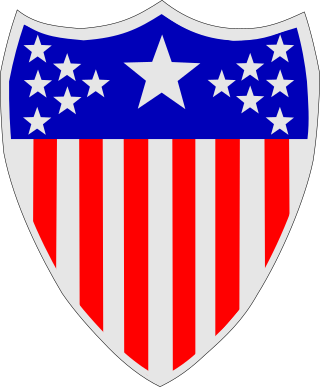
The Adjutant General's Corps, formerly the Adjutant General's Department, is a branch of the United States Army first established in 1775. This branch provides personnel service support by manning the force, providing human resources services, coordinating personnel support, Army band operations, and recruiting and retention. The objective of the Adjutant General Corps is to "maximize operational effectiveness of the total force by anticipating, manning, and sustaining military operations. HR support operations accomplish this by building, generating, and sustaining the force providing combatant commanders the required forces for missions and supporting leaders and Soldiers at all levels."
The 132nd Engineer Battalion is an engineer battalion of the United States Army. It has been formed twice, once associated with the lineage of the 196th Infantry Regiment in 1942–46, and thirty years later, in the California National Guard. Officially, due to the lineage system of the United States Army, neither unit formed under this designation is associated with the other.

The flag of the United States Space Force is the flag used to represent the United States Space Force, as well as its subsidiary units and formations. It was officially unveiled on 15 May 2020.


